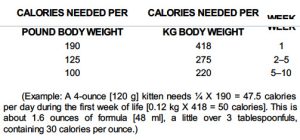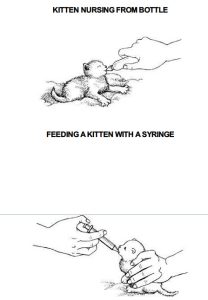CARE OF NEWBORNS
It is a rare queen who needs help caring for her kittens following delivery. The most common problem with kittens following delivery is caused by people who are too anxious to handle the kittens, upsetting the mother and causing her to move them from place to place. Since it is not customary for a veterinarian to examine the queen and kittens immediately after delivery (since problems are uncommon and handling may cause psychological upset to the mother), it is wise for a person with whom the queen is familiar to examine the kittens thoroughly within twenty-four hours following delivery to be sure they are free from defects. The sex of each kitten can also be checked at this time. After this, restrict handling of the kittens to about fifteen minutes per day until their eyes are open and they are moving about freely. Some handling is both physically and psychologically beneficial to kittens, but too much is stressful. A normal litter is quiet, and the kittens sleep most of the time they are not nursing.
Most kittens weigh between 3 to 3.7 ounces (90 to 110 g) at birth. Each kitten should gain a minimum of 7 to 10% of his or her birth weight each day following birth. Normally the birth weight will double in about ten days.
Kittens who fail to gain weight, or cry and squirm continuously, should alert you to look for signs of neglect or illness, such as weakness, inability to nurse, diarrhea, or lowered body temperature. If you find these or other signs of illness or defect, have the litter examined by a veterinarian, since treating young kittens is difficult.
First-time mothers may not have much milk during the initial twenty-four hours following delivery. The first milk is colostrum, which is rich in antibodies to help protect kittens from illness during the first few weeks of life. If at all possible, the kittens should suckle the first milk soon after birth, since they are best able to absorb these special proteins through their intestines for only the first twenty-four hours. Only small amounts are necessary, so don’t be alarmed unless the mother’s milk supply continues to seem small after the first twenty-four hours. (Test this by looking at the fullness of the mammary glands and squeezing a nipple with a milking action, from near the body to the nipple tip, with your fingers. It should be easy to express a few drops of milk.) Kittens use their sense of smell to locate the nipples, so don’t wash the mother’s breast area just before or just after delivery.
CARING FOR ORPHANED KITTENS
Cats who ignore or actively reject their litters should be examined by a veterinarian, who can sometimes solve the problem by prescribing tranquilizers. Rejection must be eliminated or the kittens will be unable to nurse, since the mother actively initiates the nursing process during the first two to three weeks of the kittens’ lives. In some of these instances, however, nothing helps. In such cases and at times when there is insufficient milk, or if the mother dies, you must take her place. If it has not been possible for the kittens to suckle the colostrum, contact your veterinarian for advice on their immunization.
Then assume care of the kittens or foster them to another nursing mother. (Nursing cats readily accept new kittens.) Try to cross-foster orphan or rejected kittens onto mothers with kittens the same age and size or supervise nursing to be sure all are getting sufficient milk.
Kittens who must be separated from a mother must be kept in an environment free from drafts because they have difficulty controlling their body temperatures. A kitten’s temperature may normally be as low as 98.6°F (36°C) at birth, increasing to 100°F (37.5°C) by seven days and it must be maintained for proper nursing to occur. From birth to about five days of age, the room or box temperature should be 85 to 90°F (29.4 to 32.2°C); from about five to twenty days, about 80°F (26.7°C). After twenty days the environmental temperature should be lowered gradually to somewhere between 70° (21.1°C) and 75°F(23.9°C) by the fourth week.
Humidity of around 60% helps prevent dehydration.
The best way to provide the proper temperature for orphan kittens if you don’t have a incubator is to use a heating pad. Water-circulating pads prevent burns, which may occur when electric pads are used. Hang the heating pad down one side of the box and onto about one fourth of the bottom. Then adjust the temperature control to maintain the proper air temperature. By covering only part of the floor of the box, you allow the kitten to get away from the heat if necessary. For kittens less than seven days of age, place the pad only on the side of the box, since their reflexes are not sufficiently developed to permit them to move if they are becoming overheated by the pad. The heating pad and box bottom should be covered with newspaper, cloth, or diapers that are changed each time they become soiled. Although newborns cannot stand or walk, they move with a swimming motion. The floor covering should provide firm footing to help them move and to avoid splaying of the legs, which can interfere with the normal development of walking.
Many authorities recommend that each kitten be kept in a separate compartment until two or three weeks of age to keep them from sucking each other’s ears, tails, feet, and genitals, but if they are allowed to suckle sufficiently at each nursing period, you will probably find that this is not necessary and can thereby avoid this unnatural rearing practice. Research has shown that kittens handled daily are more emotionally stable and resistant to stress. This does not mean, however, that children should handle them without supervision or that they should be handled by strangers (who can carry disease). Handling while feeding is sufficient for kittens less than three weeks old.
NORMAL DEVELOPMENT
Expect the dried umbilical cord to fall off a normal kitten two to three days following birth. Although kittens are blind, vision is present when the eyes open around seven to ten days of age (range of two to fifteen days).
The eyes are normally blue-gray when they first open and change to the normal adult color by four to six weeks of age. Newborn kittens can hear even though the ear canals are closed. The ear canals open at about two weeks of age. Kittens can normally support their weight on the front legs between one and two weeks of age and begin walking just after two weeks. They cannot retract their claws until about three weeks after birth and they are not steady on their feet until they are four weeks old. By five to six weeks they are running, jumping, and climbing. Use the illustration to help you sex kittens.
SEXING KITTENS

FEEDING ORPHAN KITTENS
Orphan kittens should be fed the formula that most closely approaches the composition of normal queen’s milk. Although you can get by with home formulas made from cow’s milk, cat’s milk is very high in protein (about 60% more on a dry-matter basis than cow’s milk, about five times as much as human milk) and comparatively high in fat, and commercial formulas designed for cats (e.g., KMR® and other kitten milk replacers) come much closer to the real thing. These commercial formulas are usually available in pet stores and from some veterinarians, but if they aren’t, you can use similar formulas designed for puppies that are usually readily available.
Commercial orphan kitten formulas can be used to supplement-feed large litters as well. The best way to determine how much formula each kitten needs is to weigh the kitten and use a table of calorie requirements. The required amount of formula is then divided into three portions fed at eight-hour intervals unless the kitten is very small. Kittens weighing less than 4 ounces will probably do better with feedings spaced at six-hour intervals.
If you supply the proper caloric requirements you do not need to feed most kittens more than three times a day. However, if the kitten cannot take in the required volume at three feedings, the number of feedings must be increased. At each feeding the kitten should eat until just comfortably full —not until the abdomen is tight and distended. A steady weight gain (about 1/4 to 1/3 pound, 100 to 150 grams per week) and a normal stool are indicators that the kitten is being fed properly.
HOME FORMULAS FOR TEMPORARY FEEDING OF ORPHAN KITTENS
- 4 oz (120 ml) whole milk
- 1 egg yolk (15 g)
- 1 drop multiple infant vitamins. About 30 calories per ounce (30 ml)
- 16 oz (480 ml) whole cow’s milk
- 1 tsp (5 ml) corn syrup
- 1 egg yolk (15 g)
- pinch table salt. About 30 calories per ounce (30 ml)
All formula is best fed after being warmed to body temperature (about 100°F, 37.8°C). Keep all unused formula refrigerated and all equipment used scrupulously clean to avoid introducing infection. To sterilize feeding equipment, immerse it for fifteen minutes in boiling water. Formula can be administered with an eyedropper, syringe, nursing bottle, or stomach tube.
A small syringe or eyedropper is easiest for inexperienced hands. If a nursing bottle is used, the holes in the nipple should be enlarged if the formula does not drip slowly from the nipple when the full bottle is inverted.
Be sure the nipple size is suitable for the size of kitten you are trying to nurse. Kittens need to be fed with a special pet nursing bottle or a doll’s bottle. Hold the kitten on his or her stomach. Gently separate the kitten’s lips with your fingers and slip the nipple in. A healthy, hungry kitten will usually suck vigorously after tasting the milk. Use a towel to give the kitten something to push and knead against as if nursing naturally.
Weak kittens may have to be held vertically and formula placed slowly in their mouths. Do not place a kitten on his or her back for feeding or squirt liquid rapidly into the mouth. These methods can cause aspiration of the fluid into the lungs, which will be followed by pneumonia. If you wish to use a stomach tube for feeding (the fastest method), ask your veterinarian for a demonstration.
After each feeding the kittens should be stimulated to urinate and defecate. Moisten a cotton swab, tissue, or soft cloth with warm water and gently but vigorously massage the anogenital area. Nursing kittens’ stools are normally firm (not hard) and yellow. If diarrhea develops, the first thing to do is dilute the formula by about half by the addition of boiled water. If this does not help within twenty-four hours, consult a veterinarian. Cow’s milk often causes diarrhea because of its high lactose content.

